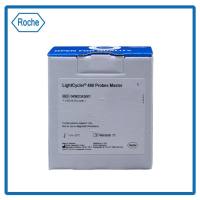Preparation of End-Labeled DNA Probes by Conventional Kinase for DNA Footprinting Analysis
互联网
1043
| Procedure | ||||||||||||||||||||||||||||||||||||||||||||||||||||||||||||||||||||||||||||||||||||||||||||||||
|
A. Restriction Digest 1. Cut 10 to 15 μg of CsCl-purified plasmid DNA containing the fragment of interest with 2-fold excess of Restriction Enzyme for 2 hours (see Hint #2 and #3). 2. Add an equal volume of Phenol:Chloroform, mix well by inversion, and centrifuge in a microcentrifuge at full speed for 3 min to separate the phases. Save the aqueous phase (upper layer). 3. To the aqueous phase, add an equal volume of Chloroform, mix well by inversion, centrifuge in a microcentrifuge at full speed for 3 min to separate the phases. Save the aqueous phase (upper layer). 4. To precipitate the DNA, add 0.1 volumes of 3 M Ammonium Acetate and 2.5 volumes of 100% Ethanol to the aqueous phase and mix well by inversion. 5. Centrifuge the tube in a microcentrifuge at full speed for 5 min to pellet the DNA and discard the supernatant. 6. Wash the pellet with 70% Ethanol, mix well by inversion, and centrifuge in a microcentrifuge at full speed for 5 min to pellet the DNA. Discard the supernatant. 7. Dry the DNA pellet by vacuum centrifugation. 8. Resuspend the pellet in 180 μl of ddH2 O. B. Calf Intestine Phosphatase Treatment 1. Add 20 μl of 10X CIP Buffer. 2. Add diluted CIP stock to the DNA such that the final concentration is approximately 0.2 Units CIP per μg DNA in a final volume of 200 μl (see Hint #4). 3. Incubate at 37°C for 1 hour (see Hint #5). 4. Add an equal volume of Phenol:Chloroform, mix well by inversion, centrifuge in a microcentrifuge at full speed for 3 min to separate phases and save the aqueous phase (upper layer). 5. To the aqueous phase, add an equal volume of Chloroform, mix well by inversion, centrifuge in a microcentrifuge at full speed for 3 min to separate the phases. Save the aqueous phase (upper layer). 6. To precipitate the DNA, add 0.1 volumes of 3 M Ammonium Acetate and 2.5 volumes of 100% Ethanol to the aqueous phase and mix well by inversion. 7. Centrifuge in a microcentrifuge at full speed for 5 min to pellet the DNA. Discard the supernatant. 8. Wash the pellet with 70% Ethanol, mix well by inversion, and centrifuge in a microcentrifuge at full speed for 5 min to pellet the DNA. Discard the supernatant. 9. Dry the pellet by vacuum centrifugation. 10. Resuspend the dried DNA in ddH2 O to a final concentration of approximately 500 μg/ml. 11. Store at -20°C. C. Kinasing Reaction 1. Combine the following: 20 μl of CIP-treated DNA (10 μg, from Step #B11) 4 μl of 10X Forward Kinase Buffer 14 μl of ddH2 O 1 μl of γ-[32 P]-ATP (CAUTION! see Hint #1) 1 μl of T4 Polynucleotide Kinase enzyme Total volume is 40 μl. 2. Incubate at 37°C for 25 min. 3. Add another 0.5 μl of T4 Polynucleotide Kinase enzyme. 4. Incubate at 37°C for 25 min. 5. Heat-inactivate the Polynucleotide Kinase enzyme by incubating at 65°C for 10 min. 6. After inactivation, add 60 μl of TE Buffer. 7. Pass the reaction over a P-10 centrifuge column in a 0.5 ml microcentrifuge tube (see Hint #6). 8. Use the flow-through containing radiolabeled DNA for subsequent steps. D. Second Restriction Digest and Extraction 1. Add the following: Approximately 100 μl of radiolabeled DNA 15 μl of 10X Restriction Enzyme Buffer 15 μl of 10 mM DTT 1.5 μl of 20 mg/ml BSA 20 Units of Restriction Enzyme ddH2 O to give an approximate final volume of 150 μl. 2. Incubate at 37°C for 2 hr. 3. Add an equal volume of Phenol:Chloroform, mix well by inversion, centrifuge in a microcentrifuge at full speed for 3 min to separate the phases and save the aqueous phase (upper layer). 4. To the aqueous phase, add an equal volume of Chloroform, mix well by inversion, centrifuge in a microcentrifuge at full speed for 3 min to separate the phases and save the aqueous phase (upper layer). 5. To precipitate the DNA, add 0.1 volumes of 3 M Ammonium Acetate and 2.5 volumes of 100% Ethanol to the aqueous phase and mix well by inversion. 6. Centrifuge in a microcentrifuge at full speed for 5 min to pellet the DNA. Discard the supernatant. 7. Wash the pellet with 70% Ethanol, mix well by inversion, and centrifuge in a microcentrifuge at full speed for 5 min to pellet the DNA. Discard the supernatant. 8. Dry the pellet by vacuum centrifugation. 9. Resuspend the DNA pellet in 20 μl of TE. 10. Add Electrophoresis DNA Sample Buffer. Mix by vortexing 10 min to dissolve the DNA completely. 11. Pour a 1.5 mm 8% native DNA preparative gel consisting of the following components (see Protocol on Preparation of Non-denaturing Preparative Acrylamide Gels for DNA): 10.7 ml of 30% Acrylamide 1 ml of 20X TBE 29 ml of ddH2 O 0.2 ml of 10% Ammonium Persulfate (see Hint #7) 60 μl of TEMED 12.After the gel has polymerized, set up the gel to run in the gel running apparatus, load the DNA, and electrophorese at 300 V until the Bromophenol Blue dye migrates approximately two-thirds of the way down the gel (see Hint #8). E. Band Excision and Electroelution Method of DNA Purification (Method #1, or see Section F for Method #2) 1. Disassemble the gel running apparatus and transfer the gel to Saran Wrap. Apply radiolabeled or phosphorescent ink dots to the Saran Wrap for alignment. 2. Determine the labeled DNA location by autoradiography (see Hint #9). 3. Line up the X-ray film with the gel and excise the band containing the labeled DNA of interest. 4. Pick up the gel slice with forceps, and place it into a dialysis bag filled with 0.5X TBE. 5. Electroelute at 150V, for 30 min (see Hint #10 and Protocol on Electroelution of DNA). 6. Transfer the solution containing the electroeluted DNA to a microcentrifuge tube and add an equal volume of Phenol:Chloroform. Mix well by inversion, centrifuge to separate the phases, and save the aqueous phase (upper layer). 5. To the aqueous phase, add an equal volume of Chloroform, mix well by inversion, and centrifuge to separate the phases. Save the aqueous phase (upper layer). 6. Place the aqueous phase into two 0.5" x 2" polyallomer tubes (for SW50.1 rotor) and add NaCl to a final concentration of 0.1 M NaCl. 7. Add 3 volumes of 100% Ethanol, cover with Parafilm, and mix carefully (see Hint #11). 8. Incubate at -80°C for between 30 min to overnight. 9. Centrifuge at 115,000 X g for 20 min at 4°C (35,000 rpm using an SW 50.1 rotor). 10. After centrifugation, remove the supernatant and vacuum dry the pellet. 11. Resuspend the pellet in 80 μl of TE by first adding 40 μl of TE to the tube to resuspend the DNA. Transfer the resuspension to a microfuge tube. Add another 40 μl of TE to the tube to rinse any remaining DNA into solution and add this suspension to the same microcentrifuge tube. Store at -20°C. 12. Proceed with Section G. F. Band Excision and Crush and Soak Method of DNA Purification (Method #2) 1. Wrap gel in Saran Wrap, and apply radiolabeled or phosphorescent ink dots for alignment. 2. Determine the labeled DNA location by autoradiography (see Hint #9). 3. Line up the X-ray film with the gel and excise the DNA of interest. 4. Pick up the gel slice with forceps, and load into a 3 ml syringe. 5. Push the gel slice 5 times through the 3 ml plastic syringe to mash it up. 6. Place the gel fragments into a 5 ml syringe that has 3 Whatman GF/C glass fiber filters in the bottom. 7. Cover the bottom of the syringe with Parafilm and place in a 17 x 100 mm polypropylene tube. 8. Add 0.5 ml Crush and Soak Buffer to the gel fragments and cover the top of the tube with Parafilm. 9. Incubate at 37°C for 2 to 3 hr with shaking on platform shaker at approximately 200 rpm. 10. Remove Parafilm covering the bottom of the syringe. Centrifuge for 1 to 2 min at approximately 1,000 X g in a clinical centrifuge. 11. Transfer the eluate to a 1.5 ml microcentrifuge tube. 12. Add 10 μg Glycogen and 2.5 volumes 100 % Ethanol to precipitate the DNA. 13. Incubate at -20°C for 30 min to precipitate and centrifuge the tube in a microcentrifuge for 5 min at full speed to pellet the DNA. 14. Discard the supernatant. 15. Resuspend the DNA pellet in 200 μl of TE. 16. Reprecipitate the DNA by adding 25 μl of 3 M Sodium Acetate and 750 μl of 100% Ethanol. 17. Incubate at -20°C for 30 min and centrifuge in a microcentrifuge for 5 min at full speed to pellet the DNA. 18. Discard the supernatant. 19. Wash the pellet with 70% Ethanol, centrifuge in a microcentrifuge for 5 min at full speed to pellet the DNA, and dry the DNA under vacuum. 20. Resuspend the DNA in 80 μl of TE. Store at -20°C. G. Determination of Radioactivity of Probe 1. Remove 1 μl from the stored DNA sample and dilute it in 9 volumes of TE. 2. Measure the amount of radioactivity incorporated into the DNA probe by counting 1 μl of the diluted sample in a scintillation counter (see Hint #12). |
||||||||||||||||||||||||||||||||||||||||||||||||||||||||||||||||||||||||||||||||||||||||||||||||
| Solutions | ||||||||||||||||||||||||||||||||||||||||||||||||||||||||||||||||||||||||||||||||||||||||||||||||
|
||||||||||||||||||||||||||||||||||||||||||||||||||||||||||||||||||||||||||||||||||||||||||||||||
| BioReagents and Chemicals | ||||||||||||||||||||||||||||||||||||||||||||||||||||||||||||||||||||||||||||||||||||||||||||||||
|
EDTA Xylene Cyanol FF Bromophenol Blue TEMED Sucrose Ammonium Persulfate Boric Acid Oligonucleotide Acrylamide SDS Magnesium Acetate gamma-[32P]-ATP T4 Polynucleotide Kinase Sodium Acetate Ammonium Acetate Ethanol DTT Restriction Enzyme Tris Zinc Chloride Spermidine Restriction Enzyme Buffer Glycogen BSA Magnesium Chloride Sodium Chloride Calf Intestine Phosphatase Isoamyl Alcohol Chloroform Phenol |
||||||||||||||||||||||||||||||||||||||||||||||||||||||||||||||||||||||||||||||||||||||||||||||||
| Protocol Hints | ||||||||||||||||||||||||||||||||||||||||||||||||||||||||||||||||||||||||||||||||||||||||||||||||
|
1. This substance is a biohazard. Consult this agent's MSDS for proper handling instructions. 2. You can make a stock of linearized DNA by digesting and CIP-treating 50 to 100 μg of DNA. Store Phenol extracted and precipitated DNA at -20°C. 3. Check the restriction digest for completion on a minigel (see Protocol on Analyzing DNA on Acrylamide gels). 4. For 50 μg of DNA, dilute 0.5 μl of the 20 Units/μl concentrated CIP stock in 50 μl of cold ddH2 O. 5. Incubation time is critical; incubate no more and no less. 6. Follow the manufacturer's instructions for the of the P-10 centrifugation column. Estimate the amount of incorporation by comparing the flow through radioactive counts to the radioactive counts remaining on the column by using a hand held survey meter. The flow through should contain at least 75% of the total radioactivity. 7. If the gel does not polymerize, make fresh Ammonium Persulfate and re-pour the gel. 8. Electrophoresis should take about 1 hr. 9. Expose to X-ray film for approximately 1 min! 10. This method should be enough to get approximately 90% of the DNA. 11. The tube will be filled nearly to the top. 12. The counts per minute (cpm) should be greater than 5,000 (best if it is greater than 10,000 cpm). |










